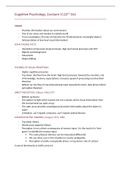Lecture notes
What has the environment got to do with psychology?
- Module
- Social Psychology
- Institution
- University Of Westminster (UOW)
The lecture is named "What has the environment got to do with psychology?". Covering environmental psychology, the theory behind personal space, territory, and territoriality, crowding, and density, crowded living conditions and their effect, urban living effect, the stress response theory and mech...
[Show more]



